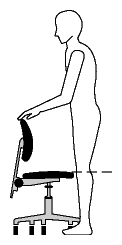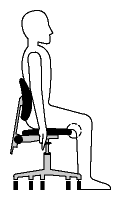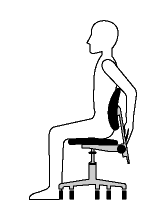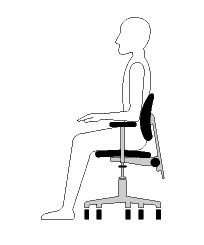Office Ergonomics -How to Adjust Office Chairs
On this page
What is the most important part about having a good workstation?
Back to topThe office workstation should let the worker sit and carry out their duties in comfort while allowing for voluntary changes in the working position.
There are three contact areas in the work space that affect the worker's posture: the seat, the work surface (commonly it is a desk top or keyboard) and the floor. To ensure the most comfortable posture possible, two of these factors have to be adjustable.
If you can afford to do nothing else, a fully adjustable chair is a "must". The other, and perhaps the most preferable option, would be a fully adjustable desk. However the price of such a desk may not make this option practical. Another effective (and cheaper) option is to use an adjustable chair and footrest to secure postural comfort.
What should I consider when selecting a chair?
Back to topA basic rule of ergonomics is that there is no such thing as an "average" person. However, providing a chair specifically designed for each individual is not practical. The only solution is to provide workers with fully adjustable chairs that can accommodate a maximum range of people (typically around 90 percent of the population; workers falling in the ranges of 5% of the shortest and the tallest will need custom-made chairs).
Choose a chair with:
- Controls that are easy to operate from sitting position.
- A seat that adjusts for both height and tilt.
- A seat that does not put pressure the back of thighs or knees.
- A seat with a front edge that curves towards the floor.
- Breathable, non-slippery fabric on the seat.
- A backrest shaped to support the lower back.
- A stable five-point base.
- Wheels or casters suitable for the type of flooring.
- A swivel mechanism.
- Armrests that can be adjusted to the elbow height when your upper arms are hanging down and your forearms are at about a 90 degree angle to the upper arms.
- Armrests that do not interfere with free movements within the workstation.
.gif)
You may also wish to check the OSH Answers document The Ergonomic Chair for more details on how to purchase a chair.
What is so controversial about armrests?
Back to topArmrests were traditionally not recommended because they can prevent the users from getting close enough to the desk. However, armrests that extend 25 cm (10 inches), or less, from the back of seat may be appropriate. People using chairs fitted with these shorter armrests can move their chairs closer to their workstations. The armrests gives them a place to rest their arms which, in turn, takes some of the load off their shoulders and neck.
How do I adjust a chair for my height?
Back to top
- Stand in front of the chair. Adjust the height so the highest point of the seat, (when in the horizontal position), is just below the knee cap.

- Sit on the chair and keep your feet flat on the floor.
- Check that the clearance between the front edge of the seat and the lower part of the legs (your calves) fits a clenched fist (about 5 cm or 2 inches).

- Adjust the back rest forwards and backwards as well as up and down so that it fits the hollow in your lower back.
- Sit upright with your arms hanging loosely by your sides. Bend your elbows at about a right angle (90 degrees) and adjust the armrest(s) height until they barely touch the undersides of the elbows.
- Remove the armrests from the chair if this level can not be achieved or if armrests, in their lowest adjustment, elevate your elbows even slightly.

- Tilt the seat itself forwards or backwards if you prefer.
Different office tasks require different equipment, accessories and layouts.
Nonetheless, the chair and its adjustment remain constant for the majority of setups in a typical office environment.
What adjustments should I make if the workstation (desk) is at a fixed height?
Back to topOnce your chair is properly adjusted for your height, check if you can sit at the workstation comfortably with your legs underneath.
- If you cannot fit your legs under the workstation or there is not enough space to move them freely, your workstation is too low for you and you should not use such a workstation on a regular basis!
- If you can sit comfortably but need to elevate your arms in order to place them over the work surface, your workstation is too high. Adjust the chair height so your elbows are about the same height as the work surface. Use a footrest if you cannot place your feet flat on the floor.
- The footrest should be adjustable and support both feet. Keep feet flat and firm on the footrest.
- Fact sheet confirmed current: 2020-01-17
- Fact sheet last revised: 2014-03-10
